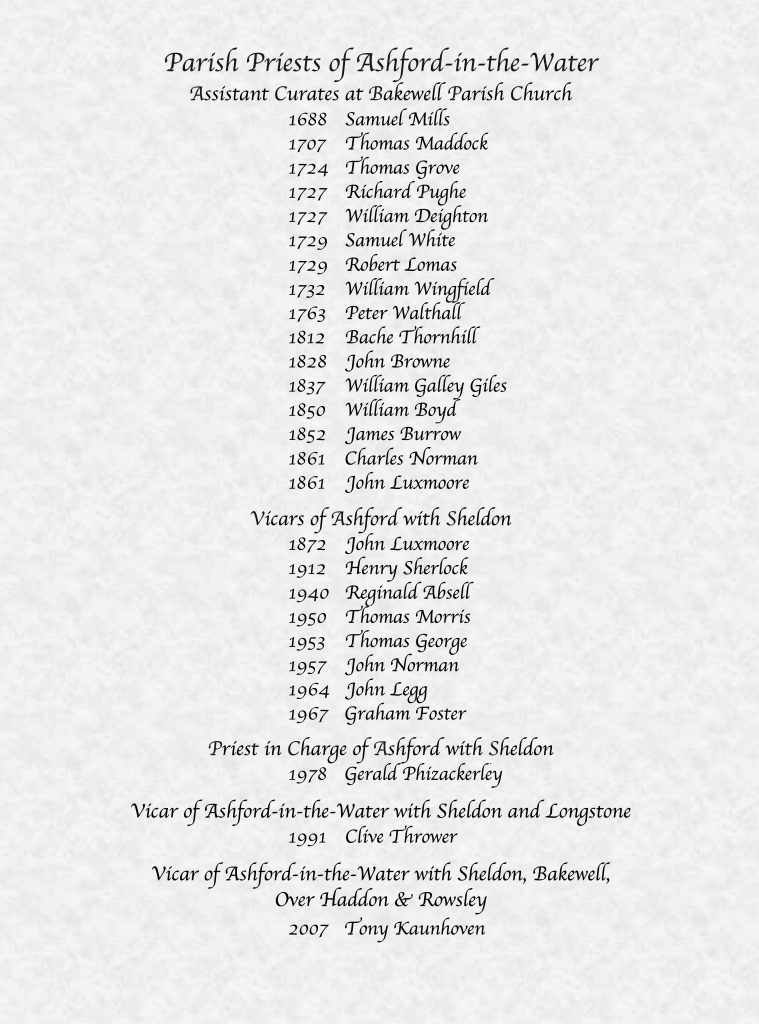History
History of Ashford
The village of Ashford in the Water, which stands on the river Wye, was an ancient settlement which appears in the Domesday Book as “Aisseford”, a pure Saxon word meaning “the ford of the ash”. We are proud of the village church and are pleased to welcome visitors; the church is open most days during the hours of daylight.
A timeline of the history of the church can be seen here.
Part of the present church at Ashford in the Water dates to around 1205, though there was probably an earlier wooden church on the same site. The oldest part is the 12.2 metre high Norman tower, the walls of which are up to one metre thick at the base. Housed within the tower are a total of 7 bells, the oldest of which is the sanctus bell which was dedicated before the reformation. For further information, see Bell Ringing. The Tower Arch is from the Decorated Period of 1370-1440.
Above the Tower Arch is the Royal Coat of Arms of George 1, dated 1724, which was restored and rehung in 1985. Below it stands the octagonal, chalice-shaped font which was sold by the churchwardens in the 18th century, and used in a local garden as an ornament. When it was restored to the church the lower part of the shaft was found to be damaged and this was replaced by a new piece of stone. The body of a dragon can be seen ‘embedded’ in the shaft, with the head and tail emerging from either side, symbolising the influence of the sacrament of Holy Baptism over sin. The font also dates from the Decorated Period of 1370-1440.
The three arches and the octagonal pillars of the north aisle date from the late 16th century. The maidens’ garlands hanging there are a touching reminder of an old English custom, when a garland was carried before the coffin of a young girl, in the funeral procession, and afterwards displayed in the church – a privilege given only to virgins. Ashford is one of only a few places which have preserved these relics which are also known as crowns or crants. Each garland is composed of a wooden frame with white paper rosettes fixed to it. A glove or handkerchief belonging to the young girl was hung from the centre, and on it was written her name, age and date of death. Originally there were seven garlands; in 1987 the four that had survived were expertly cleaned and conserved before being suspended inside perspex covers for protection. In 2022, Ann Beedham, a local artist and folk singer, performed a song that she wrote in memory of Elizabeth Blackwell who died at the age of 16 in 1801, and whose garland still hangs in the church.
In the early eighteenth century, at least one window in the church depicted heraldry tinctures that were likely associated with a prominent local family. But, by the time Revd John Reddaway Luxmoore commenced his comprehensive renovation of the church between 1868 and 1870, all the windows were plain glass. Within a few years after completion of his works, his restoration was brought vibrantly to life with the installation of three stained-glass windows in the east, west and south walls. Three further windows were installed in the twentieth and twenty-first centuries. For further information, see stained glass windows.
Also installed during the 1868-1870 restoration were the decorative ceramic tiles in the chancel (choir) and altar areas. Made by Godwin & Co of Lugwardine, near Hereford, they were renovated in 2023. Progressing from the chancel arch towards the east end of the church the geometric patterns becomes more complex; more colours are introduced (including ‘encaustic’ tiles, that feature inlaid patterns of different coloured clays); and the floor level is elevated via a series of steps. The intention of this architectural scheme was to focus the congregation’s attention on the altar where the priest celebrates the Eucharist.
The wooden cross, which stands in front of the ‘Olivier Window’, was made from charred beams which survived the fire in York Minster’s south transept in 1984. The base shows the original shape of the beams and traces of medieval paint can still be seen.
A rood-screen and loft once separated the chancel from the nave, but this was later removed. Parts of the arch between the chancel and the organ chamber are late 16th century. Six corbels in the chancel wall support the main roof beams. The fleur–de–lys, a symbol of the Trinity, is carved on one of them, whilst a second represents a head supported by hands. The stones probably date from the Norman period. The choir stalls are 20th century.
The organ, a modern two-manual instrument, was rebuilt from an older one by Adkins of Derby in 1925, overhauled in 1966 by Henry Willis & Sons Ltd, who added an extra stop, and overhauled again in 1983 when two further stops were added.
The altar came from Heanor Parish Church, replacing an older one which included some Jacobean work, which now stands by the door of the church.
The pulpit and hexagonal sounding board on the right of the nave are made of fine old oak. The Jacobean panels date from c1620, and in 1843 were made by local joiners into a pulpit with a reading desk below. The sounding board was restored in 1996.
It was an early Norman custom to fill the space between the square head of the church door and the top of the arch with a stone slab or tympanum, in Ashford’s case with a carved design showing boars and other wild animals. During Revd Luxmoore’s restoration of 1870, this stone was found in the south wall and restored to its original position over the main door.
The main pathway through the churchyard is flanked on both sides by yew trees, which are thought to be 500-600 years old. To the right of the path is all that remains of the old preaching cross. Dating from the 15th century, it is still used each year on Trinity Sunday when the village wells are blessed – an ancient tradition that was revived in Ashford-in-the-Water in 1954. It is made up of three sets of octagonal stone steps and the base of the shaft into which a wooden cross may once have been set.
To the left of the main door, by the war memorial, is a new 2000AD millennium monument which houses our local time capsule.
The parish church has stood at the centre of Ashford village for many centuries bearing witness to the living faith of the Church of England. It is preserved for all to use and is maintained, in common with all parish churches, entirely by voluntary contributions of its people and the offerings of visitors.
Do come and join us, you will be most welcome. May you leave this holy place refreshed and strengthened, and at peace with yourself and God.
Further details of the history of Ashford-in-the-Water, its church and its people, can be found in three recent publications, available for purchase on the church bookstall, or direct from the author:
- The Stained Glass at Holy Trinity Church, Ashford-in-the-Water.
- An eye-witness testimony from 1900 by a long-time churchwarden, Samuel Birley.
- The Life and Times of Revd John Reddaway Luxmoore (1829-1917).
A “well written and information packed biography.” Paul Auchterlonie, Honorary Research Fellow, University of Exeter.
“A revealing snapshot of a late Victorian/Edwardian country vicar wrestling with the issues of his times … equally good when describing the village of Ashford in Revd Luxmoore’s time … a model of local history research and narration”. Kenneth Hillier. British Association for Local History.
“An excellent publication … clearly well researched … an insightful analysis into the life of a Victorian/Edwardian clergyman, while gently uncovering the history of the parish, its church and some of its families during a time of social change … beautifully illustrated and produced, with an impressive index and bibliography.”

